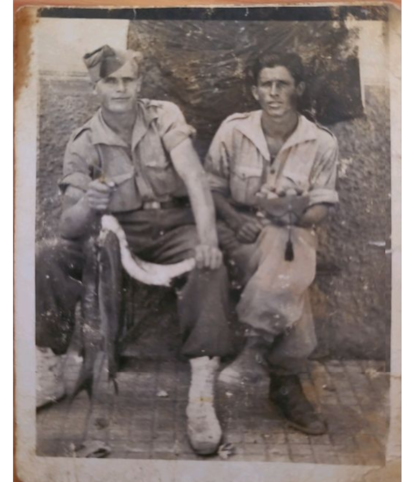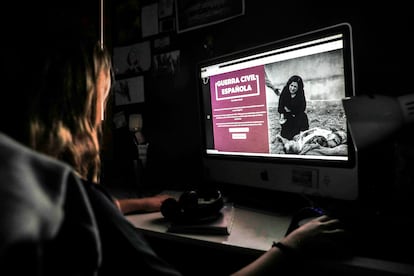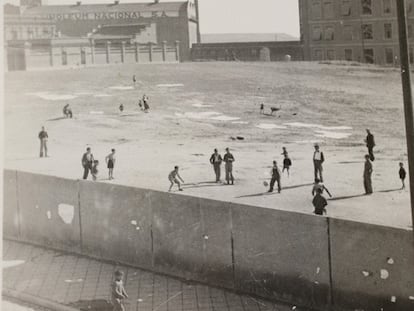The Virtual Museum of the Spanish Civil War in Canada aims to exhibit the memory of both sides
The digital project, the only center dedicated exclusively to the 1936-1939 conflict, has inaugurated new sections and encourages the public to share objects and personal experiences


Amalia Barrajón López’s family history is now global: a photograph provided by the Spaniard can be viewed from all over the world. The image shows her grandfather, Vicente López Nieto, with a comrade-in-arms during the battle of the Ebro (July-November 1938). Born in the western Spanish province of Extremadura, López Nieto was wounded twice in combat. After he married, he settled in Madrid. His personal experiences are now hung in the digital corridors of the Virtual Museum of the Spanish Civil War, the only center dedicated exclusively to the 1936-1939 conflict, inaugurated in Canada in September 2022.
The project, which already welcomed over 74,000 visitors from 130 countries, has just announced the beginning of its second phase: it will open four new galleries, increase its linguistic offer, and invite the public to share objects and personal experiences about the most important historical event of the 20th century in Spain. Meanwhile, the opening of the Civil War Museum of Teruel, financed by the regional government of Aragón, is still pending following delays but the center is expected to be completed by September.
The promoters of the initiative, professors of history Adrian Shubert of York University in Toronto and Antonio Cazorla Sánchez of Trent University, Ontario, emphasize the growing interest on the part of the public, as well as the importance of the new rooms for a better understanding and preservation of the Spanish Civil War. The platform is now available in French, in addition to the existing versions in English and Spanish.
For the museum’s creators, the most important element of this second phase is the Open Gallery. It is a room made up of photographs, letters, documents, and other objects contributed by the public like Antoine Nieto Sandoval, born in Madrid and the son of Spanish Republicans, who has lived most of his life in France as a result of his parents’ exile. He provided a letter for this gallery, with the letterhead and seal of the Republican Air Force, written and signed by his father in September 1938 at the airfield of Los Monjos, near Villafranca del Penedès in Catalonia. In the missive he extends his thanks for the delivery of a pennant made by the Young Women’s Association of Igualada, the Catalan town where Nieto Sandoval’s mother, who belonged to the association, first met her future husband; they met again later in France. “The letter represents something like the origin of our family,” writes Nieto Sandoval.

Intrafamilial history
“It is a very important space as it will allow us to tell the intimate and intrafamilial history of the Civil War, that is, its most human, diverse and nuanced side,” explains Cazorla Sánchez. Shubert explains how to participate: “We ask for a photo of the object with a text of no more than 400 words describing it, how it was obtained, and what meaning or importance it has for the sender.” Interested parties can contact the museum by emailing vscw@yorku.ca.
In addition, two new galleries focus on Catalonia and the Basque Country and the protagonists, impact, and legacy of the conflict in those regions. “The creation of these spaces is based on two important reasons: to affirm the diversity of Spain and the fact that both communities had very particular dynamics during the war,” says Cazorla Sánchez.
Another new gallery, Global, highlights how the Spanish Civil War was perceived in different parts of the world. So far, the space covers a dozen countries, but another 20 will be added soon. One example is Canada itself, where information is available on areas such as the role of the international brigade soldiers of Canadian origin, the support for General Francisco Franco’s Nationalist forces among some sectors of Canadian society, and the policy of non-intervention established by the government in Ottawa — a policy that, as a document in the gallery shows, did not prevent the Royal Canadian Mounted Police from carrying out surveillance on individuals, groups, and organizations that could have provided help to the Republican side.
Regarding the next steps, Shubert says: “The museum is a project under continuous construction, with a growing team of collaborators. We have other galleries planned. One, coming soon, on the origins of the war; another, a little later, on its aftermath. We will also open a room focused on the war in Galicia, which will have a Galician-language version. In turn, there will be a section dedicated to didactic resources.”
The Virtual Museum of the Spanish Civil War has received contributions from York University and Trent University, as well as from the Social Sciences and Humanities Research Council of Canada, the Spanish government, the Spanish Embassy in Ottawa, and the Modern Records Centre based at Warwick University in the UK. In addition, the regional government of Catalonia will cover the translation of some of the museum’s contents into Catalan.
Sign up for our weekly newsletter to get more English-language news coverage from EL PAÍS USA Edition
Tu suscripción se está usando en otro dispositivo
¿Quieres añadir otro usuario a tu suscripción?
Si continúas leyendo en este dispositivo, no se podrá leer en el otro.
FlechaTu suscripción se está usando en otro dispositivo y solo puedes acceder a EL PAÍS desde un dispositivo a la vez.
Si quieres compartir tu cuenta, cambia tu suscripción a la modalidad Premium, así podrás añadir otro usuario. Cada uno accederá con su propia cuenta de email, lo que os permitirá personalizar vuestra experiencia en EL PAÍS.
¿Tienes una suscripción de empresa? Accede aquí para contratar más cuentas.
En el caso de no saber quién está usando tu cuenta, te recomendamos cambiar tu contraseña aquí.
Si decides continuar compartiendo tu cuenta, este mensaje se mostrará en tu dispositivo y en el de la otra persona que está usando tu cuenta de forma indefinida, afectando a tu experiencia de lectura. Puedes consultar aquí los términos y condiciones de la suscripción digital.
More information
Archived In
Últimas noticias
Most viewed
- Sinaloa Cartel war is taking its toll on Los Chapitos
- Oona Chaplin: ‘I told James Cameron that I was living in a treehouse and starting a permaculture project with a friend’
- Reinhard Genzel, Nobel laureate in physics: ‘One-minute videos will never give you the truth’
- Why the price of coffee has skyrocketed: from Brazilian plantations to specialty coffee houses
- Silver prices are going crazy: This is what’s fueling the rally










































